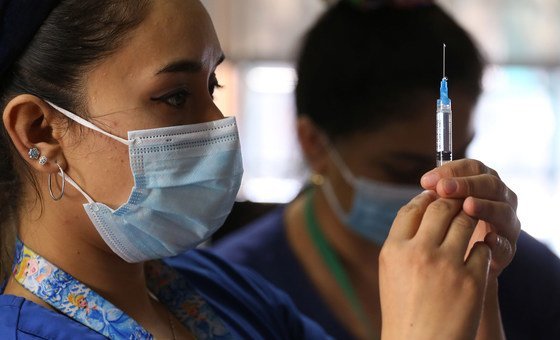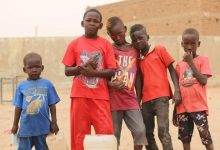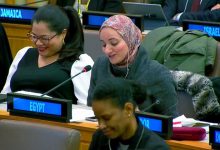UNICEF to America: Let’s Get Those 77 Million Kids Back in School After Year and a Half Out!
 The UN Children’s Fund (UNICEF) says the world is facing an education crisis due to the COVID pandemic, that has left nearly 77 million children shut out of the classroom for the past 18 months.
The UN Children’s Fund (UNICEF) says the world is facing an education crisis due to the COVID pandemic, that has left nearly 77 million children shut out of the classroom for the past 18 months.
This Thursday, the UN agency is closing down its social media channels for the next 18 hours to send one message to the world: #ReopenSchools for in-person learning as soon as possible.
The UN Educational, Scientific and Cultural Organization (UNESCO) is joining UNICEF, together with the World Bank, the European External Action Service (EEAS), the European Commission Humanitarian Aid operation, the LEGO Foundation and the WEF Global Shapers community of world youth.
Tweet URL
Right to education
For UNICEF, the right to go to school is central to every child’s development, safety and well-being. Yet in too many countries, classrooms remain closed while social gatherings continue to take place in restaurants, salons and gyms.
The agency believes “this generation of children and youth, cannot afford any more disruptions to their education.”
New numbers from UNESCO, released this Thursday, show that schools are now fully open in 117 countries, with 539 million students back in class, ranging from pre-primary to secondary levels.
This represents 35 per cent of the total student population across the world, compared to 16% who returned to school in September 2020, when schools were only open, or partially-open, in 94 countries.
Around 117 million students, representing 7.5 per cent of the total, are still affected by complete school closures in 18 countries. The number of countries with partly open schools, has declined from 52 to 41 over the same period.
In all countries that had prolonged full school closures, education was provided through a combination of online classes, printed modules, as well as tuition through TV and radio networks.
Schools can reopen safely
UNESCO and its Global Education Coalition partners have been advocating for the safe reopening of schools, urging full closures to be used as a measure of last resort.
Since the onset of the pandemic, schools were completely closed for an average of 18 weeks (4.5 months) worldwide. If partial closures are accounted for, the average duration of closures represents 34 weeks (8.5 months) worldwide, or nearly a full academic year.
For UNESCO, the past two academic years have resulted in learning losses and increased drop-out rates, impacting the most vulnerable students disproportionately.
Schools in most countries have adopted some forms of sanitation protocol such as wearing masks, using hand sanitizers, improving ventilation and social distancing, which were also key to re-opening schools last year.
Some countries have also introduced large scale testing as well as temporary classroom and school closures when the virus is detected.

UNICEF and UNESVO say teachers should e prioritized to get the COVID-19 vaccination in order to ensure a safe return to schools, by © UNICEF/Elvis González
Vaccination key
Rising vaccination rates among both general population and teaching staff, has also been a key factor in reopening schools.
The vaccination of teachers has been prioritized in around 80 countries, allowing for the inoculation of some 42 million teachers. In a handful of countries, the vaccination of students aged 12 and over, is an important factor in determining the full re-opening of schools.
Action to accelerate the recovery of learning losses remains an essential component of national COVID-19 education responses. For that, UNESCO says teachers and educators need adequate support and preparation.
Connectivity and bridging the digital divide also remain key priorities in building the resilience of education systems and providing hybrid learning opportunities.
For that reason, UNESCO, UNICEF and the World Bank have partnered in an initiative called Mission: Recovering Education 2021, that supports governments in bringing all learners back to school, run programmes to help them catch up on lost learning, and prepare teachers to address learning losses and incorporate new digital technology.
Nora Chambers, an acclaimed journalist with a focus on global affairs and humanitarian issues, has dedicated over twenty years to reporting from conflict zones worldwide. Her work has spotlighted marginalized communities and highlighted urgent international concerns.




Isn’t it concerning that while restaurants, salons, and gyms are open, classrooms remain closed for millions of children? What actions are being taken to address this disparity? #ReopenSchools
It is indeed worrying to see such a discrepancy where children are kept out of classrooms while other public places are open. UNICEF is actively advocating for the reopening of schools to prioritize children’s right to education. They are collaborating with various organizations and calling for swift actions to address this issue. Let’s join the #ReopenSchools movement to ensure all children have access to learning opportunities.
Why are some countries keeping classrooms closed while allowing social gatherings in other places?
To EmilySmith21: Some countries prioritize social gatherings over education due to various reasons such as economic interests or political decisions. Unfortunately, this often results in children missing out on their right to education, hindering their development and well-being. It’s crucial for governments to prioritize opening schools for in-person learning to ensure every child has access to quality education.
As a parent, I believe it’s crucial to prioritize getting these 77 million kids back in school for their well-being and development. Let’s #ReopenSchools and ensure in-person learning resumes as soon as possible to prevent further disruptions in their education.
As a parent, I strongly believe that getting these 77 million kids back in school should be a top priority. It’s crucial for their mental and social development to have in-person learning. Let’s support UNICEF’s call to #ReopenSchools and ensure that every child has the right to education they deserve.
As a parent, I strongly believe that our children should be back in school for in-person learning as soon as possible. The impact of this extended period of closure on their education and development is deeply concerning. It’s time to prioritize reopening schools and ensuring a safe environment for our kids.
As a parent, I completely agree that getting children back in school should be a top priority. It’s essential for their development and well-being. Let’s support initiatives like #ReopenSchools to ensure every child has access to education again.
It’s essential that we prioritize getting these 77 million kids back to school after such a long disruption. Education is crucial for their development and well-being. Let’s support UNICEF’s initiative to #ReopenSchools for in-person learning as soon as possible!